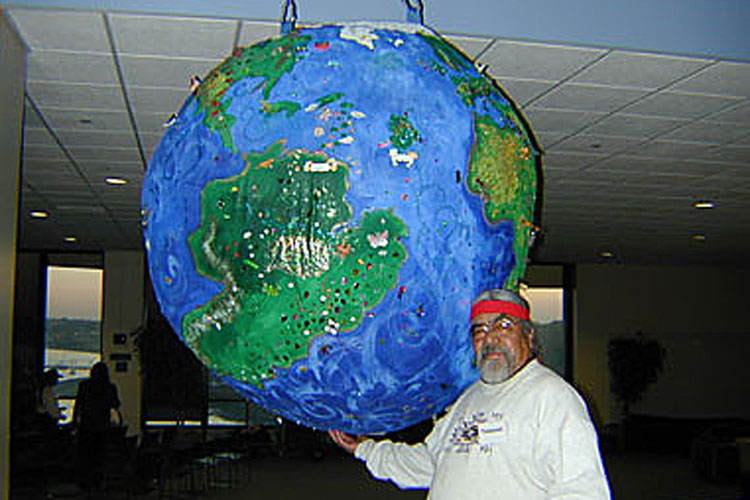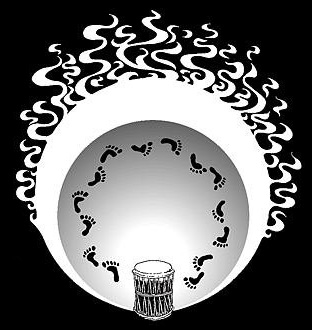
Finding Our Way Home
by Morwen Two Feathers
December, 1998
In his article (in the Nov/Dec 1998 issue of Spirit of Change), "The Lost People," Thom Hartmann speaks eloquently about the ancient tribal ways of the Europeans which were the first casualties of the violent, greed-driven materialism that became the culture of "Western Civilization." He notes that after thousands of years of dominator culture, these ancient ways have been lost. Young people in western society no longer learn these Earth-honoring ways from their elders, and instead become socialized into a culture of unrelenting individualism, consumerism, and disregard for the connectedness of all beings in favor of advancement of the ego-self.
He asks native people for compassion – and perhaps even pity – for, he asserts, while it must be true that white people once lived tribally and respectfully upon the Earth, we have become spiritually impoverished as the series of destructive dominator cultures that has become synonymous with white civilization has completely destroyed all traces the old ways, so that not even remnants remain.
Or do they? Are all the ceremonies and traditions of the neo-Pagan community simply figments of someone’s overactive imagination? Or manifestations of inappropriate creative license taken with someone else’s traditions? Can all wisdom from the white ancestors be dismissed as resulting from some sort of flaky channelling? Are Pagan festivals simply a lot of deluded people playing dress-up in the woods? Are Pagans just a bunch of wannabes building a flimsy house of cards with stolen materials?
I think not. In fact, although it is certainly true that dominator culture has done a very good job of discrediting, repressing, and in many cases even destroying the Old Ways, I believe that many traces remain, traces upon which intelligent, thoughtful people have rebuilt a functioning tradition. Indeed, the dominator culture is even today expending a great deal of energy repressing the practice of the Old Ways among whites, something we would not expect to see if these Ways were simply fanciful dabbling in imagined or stolen traditions. Although there are a few Pagan churches that have received recognition as religious institutions from the federal government, many Pagans hide for fear of losing custody of their children, their jobs, or their right to gather. These are not unreasonable fears; in some parts of the country, Pagans have lost and continue to lose all three. The Christian Right regularly harasses groups and individuals who practice and teach Pagan ways, and solicits the support of the government in doing so, organizing to elect people who share their views. Distorted media portrayals of Pagan ways as either evil or ridiculous flood mainstream culture, further reinforcing the idea that the Old Ways are completely lost and anyone attempting to resurrect them is sorely misguided.
In the face of all this, the strength and steady growth of the Pagan community is admirable. And this is attributable to the reality that many traces of the Old Ways do indeed remain, available to any who have the patience and perseverance to strip away the conditioning of the dominator culture in which we were raised in order to see them clearly.
What traces are these, you might ask? The first place they may be found is within the disciplines of archeology and ancient history, where goddess images and artifacts of daily life give many clues about the Old Ways and the way of life and worldview within which they flourished. Although there is controversy within academia about the interpretation of these artifacts, many credible scholars have concluded that these artifacts represent cultures which are the antecedents of European societies, and that they reflect a deep awareness of the cycles of nature and human life, the divinity of the feminine and of the male/female connection, and a non-violent social structure. And even more important, many people, upon seeing this material, have resonated with it and known in their hearts that this worldview is our ancient birthright. These artifacts are real, they sprang from the hands and visions of human beings not so different from ourselves, and they speak to us in ways that need no interpretation from "experts."
Perhaps even more direct are the messages left by the ancestors in the land itself. Contrary to the scenario described by Hartmann, not all of the ancestors’ sacred places were built upon by the dominator culture. Throughout northern Europe, ancient stone circles, formations, and earthworks may be found whose function as places of worship holding information about the Old Ways is indisputable to the heart. Again, there is controversy among "classical" scholars about the interpretation and meaning of these sacred places. Much of what has been written by academics and scientists about these places and the goddess images must be seen in the context of the process by which academics gain tenured positions, research funding, and credibility in the mainstream world; that is, there is a built-in bias to dismissing interpretations that are threatening to the basic foundations of dominator culture. Fortunately, there is another means of determining their meaning: Go there. Stand in the circle, and listen to what the stones and the Earth have to say.
Then there is the matter of folklore and myth. Here is another rich source of clues. Interestingly, even Christian traditions contain clues, for, contrary to Hartmann’s comment that Pagans have appropriated Christian holidays, there is ample evidence to show that the reverse is true. All over the world, in its fervor to convert indigenous people to Christianity, the Church adapted and coopted ancient tribal ways and holy days. Even Christmas and Easter were placed at the solstice and equinox. Of course, Christianity is a relative late-comer in the tragedy of the loss of the Old Ways; we can argue about whether the Celts, who were warlike (and thus qualify as dominator culture in Hartmann’s view) but also tribal and tied to the land, preserved any of the ways of the people who came before them (the ones who built the stone circles), but my point here is that even a long string of dominator cultures has been unsuccessful in completely wiping out all traces of the Old Ways. Disguised, diluted, diminished as they may be, these traces yet remain in the folklore and mythology of the people. And for those of us who look, we know them when we see them.
Throughout Europe (especially but not exclusively Great Britain) and the U.S. there are families who claim to have preserved the Old Ways in an unbroken line since ancient times. I have met members of such families, people who do not label themselves Pagan (or anything), but who know that they hold a hidden legacy. They don’t consider what they do a religion, but simply a way of life. Because they have lived in an inhospitable environment for so long, they are secretive, and not connected with each other. Yet, regardless of the "validity" of their claims of an unbroken line, it’s clear that these people hold yet more remnants of the Old Ways.
All of these remnants are but scraps, not nearly enough to clothe a whole tradition. Yet, from these scraps, we can make out some patterns. With our discernment, our knowledge, and our hearts, we can weave a new cloth that preserves those patterns of the Old Ways. And with this cloth, we can clothe our children, and make them both warm and beautiful.
This is the task facing the white neo-Pagan community today. We have some real handicaps as we approach this work, perhaps the largest of which is the lack of elders to guide us. Most of us on this path have consciously left behind the traditions in which we were raised, and thus we face the doubly difficult challenge of respecting and loving our elders while rejecting the culture they would have us join.
Fortunately, this relatively new community is vibrant, strong, and growing. In the twenty years that the Pagan community has been gathering in the greater Boston area, a whole generation of children has been raised with a new way of life. Within the community, there are several families in which there are three generations participating. As my young son grows, he will have elders to teach him in a way I have not had, and for this I am grateful.
And so, in the council circle, I look to my native brothers and sisters, and I see that, though your path stretches back unbroken much farther than mine, our journeys into the future are parallel. There is much we can learn from each other about holding fast to an Earth-honoring way of life in the face of powerful opposition. I do not look to you from a place of spiritual impoverishment, but rather of inner strength. I acknowledge the damage the dominator culture has done, and I take responsibility for working to make it right, for myself by reclaiming and reweaving the Old Ways of my ancestors, and for you by honoring and supporting your struggle for justice and respecting you as my equal. I see that in the work that must be done the heal the Sacred Hoop that has been broken, you and I are potentially powerful political and spiritual allies. I pray that through the work we do together, all the Lost People may find their way home.
